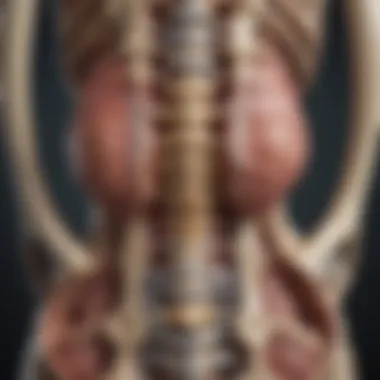Comprehensive Guide to Posterior Decompression Surgery


Intro
Posterior decompression surgery represents a nuanced surgical approach that addresses the complexities associated with spinal conditions. This procedure specifically targets the alleviation of pressure on the spinal cord or nerve roots by methodically removing obstructive bone structures and other tissues located in the back region of the spine. With the growing prevalence of spinal disorders, understanding the underlying mechanisms of such surgeries becomes increasingly pertinent for not just healthcare professionals but also patients and their families seeking clarity on the intricacies involved.
The essence of this surgery encompasses a range of techniques and strategies tailored to individual patient needs. It’s more than just a surgical procedure; it’s a vital intervention that can dramatically enhance the quality of life for those grappling with debilitating spinal issues. As we navigate through this exploration, we will uncover key insights into the indications for surgery, the methodologies employed, potential risks, and the often-overlooked recovery journey.
In delving into why this topic holds significance today, we must recognize that the spine serves as the central axis for our physical structure. When it faces adversity, the repercussions can be felt throughout the body, often resulting in diminished function, chronic pain, and loss of mobility.
By engaging with the details presented in this article, readers will not only gain a comprehensive understanding but also appreciate the advancements in spinal care that are shaping the future of this surgical domain.
Research Overview
Summary of Key Findings
Posterior decompression surgery is emerging as a pivotal method in spinal care, driven by a variety of studies highlighting its effectiveness in addressing conditions like spinal stenosis, herniated discs, and other compressive disorders. Research indicates significant improvements in symptom relief and functionality post-surgery, making it a viable option for many patients facing these challenges.
Notably, findings suggest that patients who undergo this procedure often report marked improvement in pain levels and mobility within months of the intervention. The data reveals that the long-term benefits significantly outweigh the risks associated with surgery, establishing a positive outlook for recovery and quality of life.
Importance of the Research
As spinal health continues to gain attention in both clinical and academic settings, the importance of rigorous research cannot be overstated. Understanding the outcomes associated with posterior decompression surgeries provides critical benchmarks for physicians and surgeons. This contributes not only to improved patient care but also to the evolution of best practices within surgical methodologies.
Furthermore, the insights gleaned from ongoing studies inform future innovations in surgical techniques, pushing the boundary on what is possible in managing spinal conditions. Essential to this discourse, patient education emerges as a crucial component that can empower individuals to make informed decisions about their health.
Methodology
Study Design
The myriad studies examining posterior decompression surgery typically employ a quantitative approach utilizing both randomized controlled trials and observational studies. These designs facilitate a robust analysis of outcomes, ensuring that findings are both reliable and applicable to a larger patient population.
Data Collection Techniques
Data collection is generally multifaceted, involving:
- Patient-reported outcome measures (PROMs) to gauge pain relief and functionality pre- and post-surgery.
- Imaging studies like MRI or CT scans to assess structural clarifications leading to surgical intervention.
- Follow-up appointments to monitor recovery and any potential complications that may arise.
Through these comprehensive data collection techniques, researchers can establish a clearer picture of the surgery's impact, guiding future clinical practices and patient support strategies.
Understanding the intricacies of posterior decompression surgery is not merely an academic exercise; it is a step toward enhancing the quality of life for countless individuals battling spinal health issues.
As we move forward, each subsequent section will expound upon these developments, illustrating the practical implications of this crucial surgical approach.
Prologue to Posterior Decompression Surgery
Understanding posterior decompression surgery is essential for anyone interested in spinal care or those facing potential surgical interventions. This procedure serves a critical purpose: it alleviates pressure on the spinal cord or nerve roots by removing obstructive bone or other structures. Such pressure often leads to symptoms like pain, numbness, and weakness, which can significantly impair a patient’s quality of life.
In this article, we will navigate through the intricate elements of this surgical approach, diving deep into its indication, historical background, and anatomical relevance. By shedding light on the reasons for and methods of this surgery, we aim to equip readers with both theoretical understanding and practical insights. Increasing awareness can drastically improve patient outcomes, as being informed allows individuals to make better decisions regarding their health care.
Definition and Purpose
Posterior decompression surgery is fundamentally about relieving exerted pressure in the spine. This surgical intervention is particularly targeted at those who suffer from conditions like spinal stenosis and herniated discs. The primary objective here is to restore proper function and reduce discomfort — a goal that many patients cherish and strive for. Removing segments of bones and other hindrances can lead to a remarkable turnaround in someone’s daily life.
Historical Context
To fully grasp the value of posterior decompression surgery, it's useful to look back at its evolution. Historically, surgery on the spine didn’t always hit the mark. There were plenty of hit-and-miss attempts, leading to not just pain relief failures but also further complications. However, notable advancements in techniques and technology in the late 20th century laid a solid groundwork for today's practices. Surgeons began to appreciate the delicate balance between invasive and minimally invasive techniques. This growing knowledge paved the way for procedures that offered relief with a lower risk of complications, creating a ripple effect through medical communities worldwide.
Anatomy of the Spine Involved
Understanding the anatomy intertwined with posterior decompression surgery isn’t only beneficial but vital. The spine consists of several key structures: vertebrae, discs, ligaments, and nerves. In the context of this surgery, posterior elements such as laminae and spinous processes often come into play.
- Laminae: These are the flat sections of bone that make up the back of the vertebral arch. When they become thickened due to aging or degenerative conditions, they can compress spinal nerves.
- Spinal Cord and Nerves: Located within the vertebral canal, they transmit signals that control bodily functions. Any compromise to these structures can lead to severe neurological deficits.
- Cerebrospinal Fluid (CSF): Surrounds and cushions the spinal cord; in decompression surgery, maintaining its integrity is crucial to prevent complications.
In summary, posterior decompression surgery is not only a response to anatomical challenges but also a testament to evolving medical practices. As we proceed through this article, we'll examine the myriad of factors that guide the decision to pursue such a surgical option.
Indications for Surgery
Understanding the indications for posterior decompression surgery is crucial for both practitioners and patients alike. This section delves into the situations where the surgery becomes not just a recommendation but often a necessity. When roots of the nerves or the spinal cord face constriction, that’s a situation begging for intervention. Not every backache warrants a surgical solution, but when specific conditions arise, the stakes get higher. The right timing and an accurate diagnosis can be the thin line between recovery and chronic pain.
Spinal Stenosis
Spinal stenosis occurs when the spaces within the spine narrow, putting pressure on the spinal cord and nerves. It’s often seen in older adults, largely due to wear and tear over the years. Imagine trying to drive a car through a tunnel that’s been reduced to half its size; that’s what the spinal canal experiences under stenosis.
Some key symptoms of spinal stenosis include:
- Numbness and Weakness: Reduction of nerve function leads to a sensation of weakness primarily in the legs.
- Pain: Discomfort following physical activity, often relieved by sitting or bending forward.
For many, conservative measures like physical therapy or medication may help temporarily. However, if those approaches fall flat, posterior decompression could be the viable solution to reclaim a quality of life.
Herniated Discs
A herniated disc is another condition warranting this type of surgery. Disc herniation happens when the inner gel-like core of a spinal disc bulges out through a tear in the outer layer. Here’s where the trouble brews: when this bulging material presses against nearby nerves, patients may experience severe pain, tingling, or even more disturbing loss of function.
In many cases, surgical options are recommended when:
- Conservative management fails after specific time.
- Pain radiates down to the legs or arms, indicating severe compression.
For some, it's like dealing with a thorny rose; the beauty of movement is overshadowed by the sharp discomfort of nerve pain. Once the consensus is reached that surgery is the path forward, posterior decompression can relieve the pressure and mitigate the symptoms.
Tumors and Lesions


The presence of tumors or lesions within or near the spinal cord introduces another layer of complexity. These can be benign or malignant, but either way, the pressure they exert may lead to severe discomfort and dysfunction. Surgical intervention becomes critical, not just for pain relief but also for potential removal of the tumor.
Common considerations include:
- Location of the tumor: Some tumors may be accessible through posterior approaches.
- Impending neurological deficits: If the tumor is growing and threatening nerve function, action must be taken swiftly.
Here, the focus is not only on alleviating symptoms but also on addressing the underlying condition.
Trauma and Fractures
Spinal trauma due to accidents can lead to fractures that compromise stability and nerve function. Imagine a domino effect in your spine—one misstep or accident, and the chain reaction can lead to nerve damage, paralysis, and long-term disability.
In situations of acute injury:
- Surgical decompression may be urgent to avoid lasting damage.
- Fractures resulting from falls or high-impact collisions often call for immediate assessment and intervention.
In such scenarios, decompression surgery isn’t just beneficial; it can be emergency care to save mobility and functionality.
Through this detailed examination, it's clear that indications for posterior decompression surgery span a range of conditions, each needing careful evaluation before deciding on the next steps. Engaging with healthcare professionals about these indications helps ensure informed choices, offering patients the best chances for recovery and maintained quality of life.
Preoperative Considerations
Preoperative considerations are pivotal in the journey towards successful posterior decompression surgery. This stage helps in laying a strong foundation for the surgical procedure and overall patient care. Proper preoperative assessments can mitigate risks, enhance surgical outcomes, and prepare both the patient and the surgical team for what lies ahead. Understanding the intricate details of this phase is crucial for patients, families, and healthcare professionals alike.
Patient Evaluation
A comprehensive patient evaluation is vital before undergoing surgery. This process involves gathering information about the patient's medical history, physical status, and current symptoms. Physicians evaluate the severity of the condition and the impact on the patient's quality of life.
Factors such as age, overall health, and any pre-existing medical conditions play an instrumental role in determining one's candidacy for surgery. For instance, an elderly patient with significant comorbidities may face a different risk profile compared to a younger, healthier individual. Physical examinations may include assessing strength, reflexes, and the range of motion, which provide insights into how the condition affects daily activities.
Imaging Techniques
Imaging techniques are indispensable in the preoperative phase. Tools like MRI and CT scans offer a detailed view of the spine and its surrounding structures. The images help to pinpoint the exact location of nerve compression, herniated discs, or other anomalies.
Several imaging approaches may be utilized:
- MRI (Magnetic Resonance Imaging): Particularly effective in visualizing soft tissues, MRI can outline the spinal cord, nerve roots, and any herniated discs.
- CT (Computed Tomography): This technique provides cross-sectional views and is often used when clearer images of bone structures are necessary.
- X-rays: While they provide less detailed images of soft tissues, X-rays are beneficial for assessing bone alignment and conditions like scoliosis.
Risks and Benefits Assessment
Assessing the risks and benefits before proceeding with surgery is essential. Every surgical procedure carries inherent risks, and posterior decompression surgery is no exception. Potential complications include infection, bleeding, and nerve damage, which can arise during or after surgery.
On the other hand, the benefits of surgery—such as pain relief, improved mobility, and enhanced quality of life—can be significant.
- Benefits include:
- Decrease in pain levels
- Enhanced ability to perform daily activities
- Reduction in reliance on pain medications
Engaging in an open dialogue about these factors with the healthcare team can aid in making informed decisions. Patients should feel empowered to express concerns and ask questions about every aspect of the upcoming procedure.
"Pre-surgery preparation goes beyond mere checklists; it involves a dialogue between patient and physician that fosters trust and sets the stage for a successful recovery."
Therefore, well-rounded preoperative considerations can not only smooth the path for the surgery itself but can also lay the groundwork for effective recovery and improve long-term outcomes.
Surgical Techniques
Understanding the surgical techniques employed in posterior decompression surgery is crucial for both practitioners and patients alike. This section emphasizes the different methodologies available, outlining their unique characteristics and the specific conditions they address. Knowing the advantages and considerations of each technique can substantially influence the prognosis and recovery for individuals undergoing these surgical procedures.
Laminectomy
Laminectomy is often the go-to option when the goal is to alleviate pressure on the spinal cord or nerves. During this procedure, a portion of the vertebral bone, known as the lamina, is removed. This action creates additional space within the spinal canal, which can significantly relieve symptoms caused by spinal stenosis or a herniated disc.
The key benefits of laminectomy include:
- Immediate Relief: Many patients report a significant decrease in pain almost immediately following the procedure.
- Enhanced Mobility: Post-surgery, individuals typically experience improved mobility and a greater range of motion.
However, it’s important to keep in mind that laminectomy isn't suitable for everyone. Some risks include potential instability of the spine, necessitating additional surgical interventions in the future.
Laminotomy
Laminotomy differs somewhat from laminectomy, as only a small portion of the lamina is removed. The primary goal of a laminotomy is to access the spinal canal while preserving the integrity of the surrounding structures. This approach is less invasive and may result in a quicker recovery time compared to its more extensive counterpart.
Key aspects of laminotomy include:
- Minimized Tissue Trauma: Because it’s less invasive, there’s less damage to muscles and ligaments surrounding the spine.
- Shorter Recovery: Many patients may find that their overall recovery time is significantly reduced, making it an appealing option for those hesitant about more extensive surgical procedures.
Nevertheless, it also carries its own set of risks and is typically recommended for specific cases where pressure needs to be relieved but total laminectomy may be too excessive.
Foraminotomy
Foraminotomy focuses on the surgical enlargement of the foramen, the passages where spinal nerves exit the spinal column. This technique is particularly beneficial for those suffering from nerve root compression, often due to degenerative changes or herniated discs.
Advantages of foraminotomy include:
- Targeted Approach: By specifically targeting the nerve exit points, this technique minimizes the risk to surrounding neural structures.
- Less Invasive Option: Compared to more extensive procedures, foraminotomy allows for quicker recovery and rehabilitation, often leading to faster symptom relief.
It’s worth noting though that foraminotomy may not be enough if there are multiple areas of compression or more extensive spinal issues. Each case is unique.
Use of Microsurgical Techniques
Microsurgical techniques represent the cutting edge of surgical procedures for relieving spinal compression. This involves the use of advanced microsurgical instruments and techniques to operate with precision, often under the magnification of a microscope.


Some notable benefits of microsurgery include:
- Reduced Recovery Time: Many patients benefit from shorter hospital stays and less postoperative pain.
- Lower Risk of Complications: The minimally invasive nature of these procedures significantly lowers the risk of complications, which is a major concern in traditional surgeries.
The adoption of microsurgical techniques is growing, yet they require a high level of skill and expertise from the surgical team. As technology continues to advance, these methods are bound to become more prevalent, leading to better patient outcomes and satisfaction.
"An informed patient is a better patient. Understanding the surgical techniques can greatly enhance the overall experience and results."
In summary, the surgical techniques employed in posterior decompression surgery vary tremendously in their applications, invasiveness, and recovery implications. A careful consideration of these options, along with a discussion with a healthcare professional, can assist patients in making informed choices tailored to their specific health needs.
Intraoperative Protocols
In the realm of posterior decompression surgery, intraoperative protocols serve as the backbone of the surgical process. These protocols encompass various elements aimed at enhancing patient safety and surgical efficacy. From anesthesia considerations to surgical setup and monitoring techniques, every stage contributes significantly to the overall outcome. Adhering to well-defined protocols enables surgical teams to navigate complexities and reduce unpredictability in the operating room.
Anesthesia Considerations
The choice of anesthesia plays a crucial role during posterior decompression surgery. General anesthesia is most commonly used, ensuring that patients are completely unconscious and free of pain throughout the procedure. Not only does this level of anesthesia facilitate surgical ease, but it also helps in managing any potential patient movements, which can pose risks during delicate spinal manipulations.
Some considerations for anesthesia include:
- Patient Medical History: Anesthesiologists review any prior reactions to anesthesia and other medical conditions that could affect anesthesia delivery.
- Age and Physical Condition: The overall health of the patient informs the approach, particularly in older patients or those with comorbidities.
- Type of Surgery: The complexity of the surgery may dictate specific anesthetic techniques, such as positioning the patient safely for the surgery while ensuring optimal access.
A thorough understanding of these factors is essential in ensuring a smooth surgical experience and avoiding complications related to anesthesia.
Surgical Setup
The surgical setup is another critical component of intraoperative protocols. A well-organized operating room not only streamlines procedures but also minimizes the time that the patient is under anesthesia, which is beneficial for recovery. The preparation involves several key aspects:
- Instrumentation: Surgical instruments must be sterilized and organized for quick access. This can include laminectomy instruments or microdiscectomy tools, depending on the specific procedure.
- Positioning of the Patient: Correct positioning on the operating table is vital to provide the surgeon with optimal access to the spine. The prone position is common, allowing for better visualization and manipulation of the spinal anatomy.
- Collaboration Among Staff: The surgical team, including nurses and anesthesiologists, must communicate effectively during setup. This ensures everyone is on the same page regarding tasks, changes, and contingencies during the surgery.
The efficiency of this setup can significantly enhance the surgical experience, allowing the medical personnel to stay focused on critical tasks rather than being bogged down by disorganization.
Monitoring Techniques
Continuous monitoring of the patient is paramount during the surgical procedure. Various techniques are employed to keep a close eye on vital signs, neurophysiological parameters, and general patient well-being.
Common monitoring techniques include:
- Electrocardiograms: Tracking the heart's rhythm is essential to detect any abnormalities during the surgery.
- Blood Pressure Monitoring: Continuous blood pressure readings help in managing intraoperative fluctuations that could signify distress.
- Neuromonitoring: In surgeries involving the spinal cord, intraoperative neuromonitoring can provide live feedback on neural function, alerting the surgeon to possible nerve damage during the procedure.
Ensuring meticulous monitoring is non-negotiable—it's the crux of maintaining patient safety and successful surgical outcomes.
In summary, intraoperative protocols in posterior decompression surgery draw together critical elements of an anesthesia plan, surgical setup, and monitoring techniques. By prioritizing organization and precision throughout these steps, surgical teams can significantly enhance patient safety and optimize surgical success.
Postoperative Care
Postoperative care is a critical component of the overall success of posterior decompression surgery. Once the operation is complete, the patient’s journey towards recovery begins. The importance of comprehensive postoperative care can't be overstated; it directly affects not only the recovery time but also the long-term outcomes and overall quality of life for the patient. This section delves into the immediate recovery phase, pain management, and the significance of physical rehabilitation post-surgery.
Immediate Recovery Phase
The immediate recovery phase typically starts in the post-anesthesia care unit (PACU). Here, patients are monitored closely as the effects of anesthesia begin to wear off. Nurses and medical staff assess vitals like heart rate, blood pressure, and oxygen levels, ensuring everything is normal. Patients might exhibit grogginess or confusion as they awake, which is perfectly normal, but close observation is necessary to identify any potential complications immediately.
During this period, it’s essential to promote a calm environment. Keeping noise levels low and limiting visitors can aid in quicker recovery. Medical professionals will encourage patients to take deep breaths and help them reorient themselves. Patients may also begin a gradual introduction to mobility, often assisted by a physical therapist, which marks the initial steps towards reclaiming their independence.
Pain Management
Pain management after surgery is another cornerstone of effective postoperative care. Pain levels can vary widely from patient to patient, so customized pain management plans are necessary. This can include a combination of prescribed medications such as opioids for severe pain, anti-inflammatory drugs, and sometimes nerve blocks.
- Multimodal Approach:
- Utilization of various medications to tackle pain from different angles.
- Non-pharmacologic methods, such as heat or cold therapy, can also play a role in alleviating discomfort.
Patients should engage in candid discussions with their healthcare providers about their pain levels, as timely adjustments to pain relief strategies are crucial.
Physical Rehabilitation
Physical rehabilitation is key for restoring function and mobility following surgery. Engaging in a prescribed rehabilitation program yields multiple benefits. It aids in strengthening muscles, enhances flexibility, and helps patients regain their confidence in movement.
- Components of Rehabilitation:
- Initial Assessment: A physiotherapist evaluates the patient’s condition post-surgery before devising a tailored rehabilitation plan.
- Strengthening Exercises: Focused on rebuilding muscle strength around the surgical site.
- Mobility Training: Gradual increase in activities, starting with basic movements and eventually progressing to more challenging ones.
It’s important to note that each patient’s rehabilitation timeline may vary based on their individual health status, the extent of the surgery, and their adherence to the rehabilitation protocol.
"The success of postoperative care hinges on effective pain management and an active rehabilitation regimen, paving the way for long-term recovery and improved quality of life."
In summary, postoperative care in posterior decompression surgery is multi-faceted and demands careful planning and execution. By addressing immediate recovery needs, instituting effective pain management strategies, and engaging in a robust rehabilitation program, the likelihood of favorable outcomes increases significantly.
Complications and Risks
When delving into posterior decompression surgery, understanding the complications and risks involved is paramount. These factors not only inform decision-making for patients but also guide surgeons in preparing for potential outcomes. The landscape of complications can be inconsistent, varying from minimal to significant. Thus, a robust comprehension of these risks helps in devising comprehensive management strategies to ensure optimal patient care.
Infection
Infection stands out as one of the most critical risks associated with spinal surgeries, including posterior decompression. It's a daunting prospect that can occur at the surgical site or even deep within the spinal column. Factors such as the patient's overall health, type of surgery performed, and postoperative care significantly influence the likelihood of an infection.
According to clinical studies, infections may occur in about 1% to 7% of spinal surgeries. The potential consequences range from prolonged hospital stays to serious complications like sepsis. When an infection does arise, symptoms such as fever, redness at the incision site, or unmanageable pain can manifest.
To tackle infection risks, proactive measures are indispensable:


- Preoperative screenings to identify potential risk factors, such as obesity or diabetes.
- Prophylactic antibiotics administered during surgery to minimize risk.
- Meticulous surgical techniques that limit tissue damage and promote cleaner surgeries.
Implementing these strategies may not completely eliminate the risk of infection, but definitely minimizes it significantly.
Nerve Damage
While posterior decompression aims to alleviate nerve pressure, there exists a paradox where the very procedure intended to heal can lead to nerve damage. This can occur due to several factors, including excessive tissue manipulation or complications with neighboring structures during surgery.
Incidents of nerve damage can happen in approximately 1% to 3% of cases. The implications can be far-reaching, encompassing numbness, weakness, or even debilitating pain depending on the area affected. In more severe instances, there may be lasting consequences that impact overall function.
Surgeons take various precautions to mitigate nerve damage, such as:
- Preoperative imaging, like MRI or CT scans, to plan the surgery meticulously.
- Utilizing intraoperative neuromonitoring to observe nerve function and minimize risk.
- Having skilled surgical teams who are experienced in handling complex anatomical variations.
Understanding the possibility of nerve damage shouldn’t instill fear but rather inspire a collaborative approach between patients and surgeons to discuss strategies that prioritize safety.
Recurrence of Symptoms
Despite successful surgery, some patients may experience a recurrence of symptoms, which is one of the more frustrating aspects of this type of procedure. This can manifest weeks, months, or even years after surgery. The causes for recurrence can vary significantly, ranging from original spinal issues not adequately addressed to the development of secondary conditions. It is estimated that around 5% to 20% of patients may grapple with recurring symptoms post-surgery, influencing their quality of life.
Factors contributing to this phenomenon include:
- Inadequate decompression during surgery, leaving areas of pressure intact.
- Age and preexisting conditions, like arthritis, affecting spinal stability.
- Lifestyle choices such as lack of physical activity, which can exert additional strain on the spine.
To strike back at the recurrence of symptoms, postoperative monitoring and lifestyle adjustments play a crucial role:
- Regular follow-up appointments to assess recovery and address emerging issues.
- Physical therapy to strengthen the spine and improve function.
- Adopting healthier lifestyles, including exercise and weight management, to support spinal health.
In essence, while complications and risks are inherent in posterior decompression surgery, they shouldn’t overshadow the potential benefits. Awareness, proper planning, and robust follow-up care are essential components in mitigating these risks and ensuring favorable long-term outcomes.
Long-Term Outcomes
Understanding the long-term outcomes of posterior decompression surgery is crucial for both patients and healthcare providers. These outcomes not only reflect the effectiveness of the surgery itself but also indicate how well patients can manage their lives post-operation. Key elements to consider include enhancements in patients’ quality of life and the extent of functional improvements achieved through the procedure. It's important to note that outcomes can vary based on individual circumstances such as age, health conditions, and the specific pathology being addressed.
Patient Quality of Life
After undergoing posterior decompression surgery, many patients report a significant boost in their quality of life. This surgery often alleviates persistent pain associated with conditions like spinal stenosis or herniated discs. Once the pressure on nerves is relieved, patients may find that everyday activities become manageable again.
- Pain Relief: For many, experiencing chronic pain can profoundly affect mental well-being. After surgery, patients frequently describe a noticeable reduction in pain levels, which can lead to improved mood and emotional health.
- Increased Mobility: Patients often regain mobility that had been limited prior to the surgery. Activities such as walking, bending, or even sitting can become less daunting, leading to an overall sense of freedom.
- Social Engagement: With less pain and better mobility, many patients feel encouraged to engage in social activities they might have avoided. Reconnecting with friends or pursuing hobbies can lead to not just a better outlook, but also enhanced relationships.
One study indicated that over 70% of patients felt their quality of life had improved by a significant margin six months post-operation. This improvement can often lead to a more active lifestyle, which is closely linked to better long-term health outcomes.
"Quality of life is not just a concept; it's the ability to enjoy life beyond the surgery."
Functional Improvement
Functional improvements seen in patients following posterior decompression surgery are another vital aspect to discuss. The surgeries aim to restore nerve function by decompressing areas where nerves may be pinched or compromised. As a result, the following enhance:
- Daily Activities: Many patients find simple tasks like lifting items, climbing stairs, or exercising much easier post-surgery. This newfound capability often leads to a more enjoyable daily life.
- Work Performance: For patients who had to take time off work due to debilitating symptoms, returning post-surgery often brings a renewed sense of purpose. This not only helps in aspects of financial stability but also in regaining a sense of identity tied to professional life.
- Long-Term Functionality: Research indicates that the benefits of surgery can last years, with many patients retaining functional improvements over time. While some may experience recurrence of symptoms, it tends to occur in less severe forms than before surgery.
The blend of improved quality of life and functional capabilities paints a hopeful picture for those facing the daunting prospect of spinal surgery. With appropriate follow-up care and rehabilitation, many patients can see continued progress long after they leave the operating room.
Future Directions in Posterior Decompression Surgery
Posterior decompression surgery is ever-evolving, influenced by advancements in various fields of medical science and technology. Understanding the future possibilities in this surgical realm is crucial because it shapes how we address spinal issues moving forward. This section will delve into two critical areas that hold promise for the future: advancements in technology and ongoing research through clinical trials. Together, these elements could significantly change how patients experience treatment and recovery, ultimately enhancing patient care.
Advancements in Technology
Technological innovation is the lifeblood of modern medicine, and posterior decompression surgery is no exception. Emerging tools and techniques are set to redefine the capabilities of surgeons and the experiences of patients.
- Minimally Invasive Techniques: The trend towards minimally invasive surgery continues to grow, minimizing the trauma associated with spinal procedures. Instead of making large incisions, surgeons can use smaller openings and advanced instruments, like endoscopes, that provide better visualization of the targeted area. For patients, this means less pain, shorter recovery times, and a reduced risk of complications.
- Enhanced Imaging Methods: Innovations in imaging technologies, such as intraoperative MRI and CT scans, are becoming game-changers. They allow surgeons to visualize the spinal anatomy with exceptional accuracy and make real-time decisions during the procedure. This helps in precise decompression, potentially leading to better outcomes.
"Progress in imaging techniques doesn't just improve the surgical process; it fundamentally redefines surgeon-patient interactions, building a bridge of trust through informed, real-time decision-making."
- Robotics and Automation: There's also a rise in the use of robotic systems in spinal surgeries. Robots can increase precision during decompression and ensure that movements are exact, improving the effectiveness of the surgery. These systems often enhance the surgeon's ability to perform complex tasks without losing focus.
Emphasizing these technological advancements can improve techniques, maintain better standards of care, and lead to more favorable surgical outcomes for patients undergoing posterior decompression surgery.
Research and Clinical Trials
The landscape of medicine is constantly shifting, largely fueled by research and clinical trials. For posterior decompression surgery, ongoing studies are essential for understanding its efficacy and refining the techniques involved.
- Assessing Long-Term Outcomes: Clinical trials centered on evaluating long-term outcomes for patients who have undergone decompression surgery are crucial. Gathering data over many years helps to ascertain not just the success of the surgery but also the quality of life and functional capabilities of patients afterward.
- Innovative Drug Therapies: Research is also turning toward the incorporation of drug therapies post-surgery to enhance recovery. Studies are looking into innovations in pain management, which may allow patients to recover with minimal discomfort and fewer opioid prescriptions, addressing both recovery effectiveness and the opioid crisis.
- Comparative Effectiveness Research (CER): Future studies comparing various surgical techniques and approaches will provide invaluable insights into the best practices in spinal care. By analyzing which methods yield the best patient outcomes, medical professionals can adapt their approaches accordingly.
End
In sum, the conclusion serves as a vital culmination of everything we've discussed about posterior decompression surgery. It's more than just a final bow; it’s where we synthesize the importance of the knowledge shared and the practical implications for various audiences. This section spots light on the surgical processes, patient care, and evolution in spinal health treatment, offering an overview that resonates with both academic audiences and healthcare providers.
Recap of Key Points
To reflect back, there are several core elements to keep in mind:
- Definition and Purpose: Posterior decompression surgery aims at alleviating pressure on nerve roots and the spinal cord, addressing conditions like spinal stenosis.
- Techniques: Understanding the specific surgical interventions, such as laminectomy and foraminotomy, reveals how varied approaches tackle similar problems.
- Understanding Complications: Knowledge about potential complications—including infection and nerve damage—arms both patients and practitioners with the foresight needed to navigate postoperative challenges.
- Future Directions: The exciting advancements on the horizon hint at more refined techniques and improved outcomes for patients, emphasizing the field's rapid evolution.
In recognizing these points, it becomes clear how interconnected they are within the scope of posterior decompression surgery. Each component adds to a broader understanding, helping to clarify what patients can expect on their healing journey.
Final Thoughts on Surgical Protocols and Patient Care
As we close the discussion, it’s crucial to consider the balance between surgical protocols and attentive patient care. Given that every patient's experience is unique, tailoring the approach based on individual needs can make a world of difference.
Surgical guidelines must ensure precision, but follow-up care deserves equal attention. Pain management strategies should not only aim to minimize discomfort but also to enhance recovery experiences. For instance, a well-structured rehabilitation program can speed up the return to daily activities and improve overall satisfaction with the surgical outcome.
In addition, the patient's role in their own recovery can’t be overstated. Education about the procedure and active involvement in follow-ups can encourage positive outcomes.
This dialogue between surgeon and patient can foster a sense of trust and clarity. As both surgery and technology advance, a commitment to patient-centered care is essential in navigating the complexities of spinal health.
"A good surgeon knows how to make the right incision, but a great surgeon knows how to listen to the patient."



